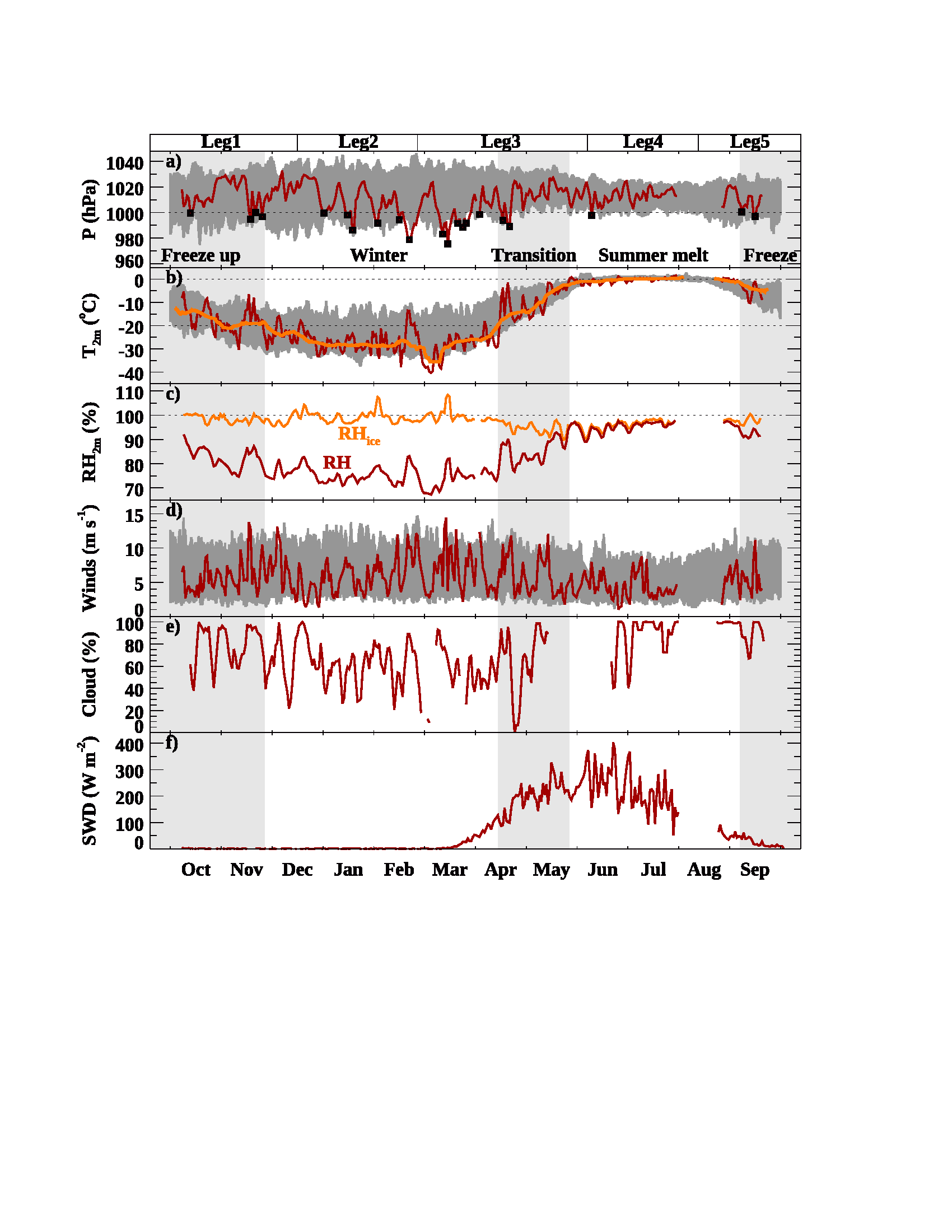Atmosphere and coupled system science at MOSAiC
Submitter
Shupe, Matthew — University of Colorado
Area of Research
Radiation Processes
Journal Reference
Shupe M, M Rex, B Blomquist, P Persson, J Schmale, T Uttal, D Althausen, H Angot, S Archer, L Bariteau, I Beck, J Bilberry, S Bucci, C Buck, M Boyer, Z Brasseur, I Brooks, R Calmer, J Cassano, V Castro, D Chu, D Costa, C Cox, J Creamean, S Crewell, S Dahlke, E Damm, G de Boer, H Deckelmann, K Dethloff, M Dütsch, K Ebell, A Ehrlich, J Ellis, R Engelmann, A Fong, M Frey, M Gallagher, L Ganzeveld, R Gradinger, J Graeser, V Greenamyer, H Griesche, S Griffiths, J Hamilton, G Heinemann, D Helmig, A Herber, C Heuzé, J Hofer, T Houchens, D Howard, J Inoue, H Jacobi, R Jaiser, T Jokinen, O Jourdan, G Jozef, W King, A Kirchgaessner, M Klingebiel, M Krassovski, T Krumpen, A Lampert, W Landing, T Laurila, D Lawrence, M Lonardi, B Loose, C Lüpkes, M Maahn, A Macke, W Maslowski, C Marsay, M Maturilli, M Mech, S Morris, M Moser, M Nicolaus, P Ortega, J Osborn, F Pätzold, D Perovich, T Petäjä, C Pilz, R Pirazzini, K Posman, H Powers, K Pratt, A Preußer, L Quéléver, M Radenz, B Rabe, A Rinke, T Sachs, A Schulz, H Siebert, T Silva, A Solomon, A Sommerfeld, G Spreen, M Stephens, A Stohl, G Svensson, J Uin, J Viegas, C Voigt, P von der Gathen, B Wehner, J Welker, M Wendisch, M Werner, Z Xie, and F Yue. 2022. "Overview of the MOSAiC expedition—Atmosphere." Elementa: Science of the Anthropocene, 10(1), 10.1525/elementa.2021.00060.
Science

Figure 1. Surface-based atmospheric observations during the MOSAiC year. Daily-averaged (a) atmospheric sea-level pressure, with individual cyclone events identified (black squares); (b) 2-m temperature (red) and a 7-day running mean 2-m temperature (orange); (c) 2-m relative humidity with respect to liquid water (red) and ice water (orange); (d) 10-m wind speed all measured from the met tower at Met City; (e) daily cloud occurrence fraction from a ceilometer onboard Polarstern (with gaps when Polarstern left the MOSAiC ice floes); and (f) downward shortwave radiation measured at Met City. While Met City was not operational during mid-May to mid-June, most measurements were provided by an Atmospheric Surface Flux Station that remained at the MOSAiC ice floe. The 5th–95th percentile range of ERA5 results at the moving MOSAiC position is given (gray shading) in (a), (b), and (d). The MOSAiC Leg periods are shown along the top, and a general characterization of seasons, as described in the text, is provided with alternating gray and white background shading. From journal.
The Multidisciplinary drifting Observatory for the Study of Arctic Climate (MOSAiC) expedition comprised a year of coupled atmosphere, sea ice, and ocean measurements in the rapidly changing central arctic sea ice. Observations from the campaign are providing deep and unprecedented insight into physical, chemical, and biological processes that cut across the arctic system and are inextricably linked with arctic change.
Impact
Based on the year in the arctic sea ice, scientists are advancing our understanding of the sources and properties of arctic aerosols, the influences clouds have on the surface energy budget, precipitation as a sink of atmospheric moisture and source of snowfall on the surface, the evolving structure of the stratified boundary layer, the impacts of storms on sea ice movement and melt, and many other atmospheric processes and their interactions with the sea ice, snow, ocean, and ecosystem. Collectively, these observations and analyses are forming the foundation for unique model process assessment that will lead to advanced model predictive capabilities.
Summary
The arctic system is in a state of rapid transition, with rising temperature, declining sea ice, and uncertain interactions with the global climate system. Models struggle to represent many of the unique features of the arctic system, including mixed-phase clouds, stable atmospheric boundary layers, the partitioning of surface energy budget terms, the layering of ice and snow, ocean mixing, and many others. To help address these needs, the MOSAiC expedition drifted with the sea ice in the central Arctic from September 2019 to September 2020 to help answer the leading question: What are the causes and consequences of an evolving and diminished arctic sea ice cover? While sea ice and its change was the scientific nexus of MOSAiC, the expedition was designed to study all related aspects of the central arctic climate system and its interactions. To complete this largest arctic scientific expedition in history required a broad consortium of international institutions and agencies, including the U.S. Department of Energy Atmospheric Radiation Measurement (ARM) user facility, which operated its second Mobile Facility as a major component of the MOSAiC atmospheric program. Overall, the expedition has produced a huge legacy of data that is unlike anything available in the past for understanding and modeling the arctic system. A collection of overview papers outline the MOSAiC programs for atmosphere, sea ice and snow, and ocean research, and how these were designed to support multidisciplinary science and model advancement.
Keep up with the Atmospheric Observer
Updates on ARM news, events, and opportunities delivered to your inbox
ARM User Profile
ARM welcomes users from all institutions and nations. A free ARM user account is needed to access ARM data.


















